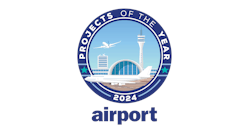Many U.S. airports are bursting at the seams with increasing passenger and cargo traffic and are under severe pressure to replace outdated facilities to keep pace with growing demand. Reconstruction or replacement of existing facilities in a busy 24/7 operational environment — whether terminal, landside or airside — often must be completed within tight schedules and highly congested and constrained work areas.
A coordinated, multi-disciplined approach to construction phasing allows airports to rehabilitate or replace outdated facilities in efficient, coordinated sequences over a predetermined period and within available footprints. This approach helps minimize airport disruptions, maintains required passenger and cargo services and needed security measures. It also enables a safe environment for airport and airline operations, passengers, vehicle traffic, pedestrians and contractors.
A coordinated phasing approach also can save time, money and space by eliminating the need to build temporary structures that are demolished once new ones go into service.
To be most effective, phasing plan development demands meticulous planning, design and execution, and should consider the following factors:
Start with the end in mind
Successful phasing plan development begins with the end condition. All decisions should be focused on how to most efficiently get from today’s conditions to the completion of construction. As program designs evolve and are refined, the phasing plans should be updated in tandem.
Know your constraints and consider timing
Before spending time developing phasing concepts, take some time to understand program constraints. What is the target opening date? What is the soonest an existing facility can be closed? What are the peak travel hours, operational patterns, seasons and holidays that need to be accommodated? What are the flight schedules and fleet mix during the anticipated construction window? Are there weather, surface concerns and criteria that must be considered?
Don’t forget the utilities
The initial planning efforts surrounding phasing plan development often involve questions of how to maintain access to the primary airport facilities during construction. Supporting these facilities is typically a complex web of underground utilities, including power, communications, water, storm drainage, sewer, natural gas and fuel lines that may be out of sight, but must be considered when developing any phasing plan. Many times, maintaining utility services to existing buildings or other facilities will drive significant portions of an overall construction sequence.
Off-the-shelf approaches don’t work
No two airports are alike, with different airfield layouts, terminal and landside configurations, airline and aircraft mix, operational patterns, peak travel times and climate conditions. Phasing plans must be similarly unique and specific to the project, the site and the owner’s and users’ needs. Applying cookie-cutter approaches may not work.
Accommodate change
It is rare when actual construction is completed exactly in accordance with the plan, especially for large, complex, multiyear programs in the dynamic, around-the-clock operational environment of an airport. A good phasing plan will be flexible enough to enable airport operations, contractors and others to respond to unforeseen or changed conditions without detrimental effects to the overall progression of work.
Refine, communicate. Modify, communicate
Clear, consistent communication with the stakeholder team is essential while the plan is refined throughout the final design process. It is important to develop a comprehensive communications plan in the earliest planning stage and choose the communication modes, frequency and content that best suits the team and the project.
The right delivery method
A construction phasing plan also is affected by the chosen delivery method. Most airport projects are delivered with one of three common project delivery mechanisms.
- Design-bid-build, historically the most common at airports, involves the airport producing detailed design documents (often under contract with a design firm) and awarding a construction contract to the lowest qualified bidder.
- Design-build uses a single entity, typically a construction firm or joint venture, to design and build a complete project based on owner provided programming or scoping documents and can be appropriate for large, fast-tracked projects.
- The construction manager at risk delivery method, sometimes known as GMGC or GCCM, is a hybrid between D-B-B and D-B methods, with a designer contracted to the airport similar to D-B-B and a second contract, typically executed around 60 percent design completion, for a construction manager. The CMAR is responsible for managing and awarding individual construction contracts. The CMAR delivery method can be an effective way to engage a construction team early in the design process to facilitate phasing plan development on large and complex airport projects without precluding individual specialty and building contractors performing the work.
Each delivery method has advantages and disadvantages, so the selected method should be based on the unique needs of a particular project and its stakeholders.
Focusing on these strategies while developing construction phasing plans will lead to the most effective possible plans and will enhance construction efficiency and safety.
Rob Millar, PE, is aviation department manager in HNTB’s Bellevue, Washington office. He has more than 27 years of experience in specialized design, planning and project management at airports, working on airport improvement projects in Washington, Oregon, Utah, Idaho, Alaska and California. He also assists clients with operational evaluations and cost-benefit analyses, CIP project costs, construction phasing planning and airport layout plans; airline and FAA coordination, airspace evaluations; construction services; and environmental documentation, and regulatory and permitting agency coordination.
Chuck Dedmon, PE, is an aviation project manager in HNTB’s Bellevue, Washington office. He has more than 20 years of experience in the civil engineering design of airports. His design experience includes geometrics, civil design, airfield lighting, apron layout and aircraft movement modeling, cost estimating, and specifications. Dedmon’s project experience includes work at both domestic and international airports, including Salt Lake City International, Seattle-Tacoma International, Hamad International in Doha, Qatar and Jorge Chavez International Airport in Lima, Peru.







